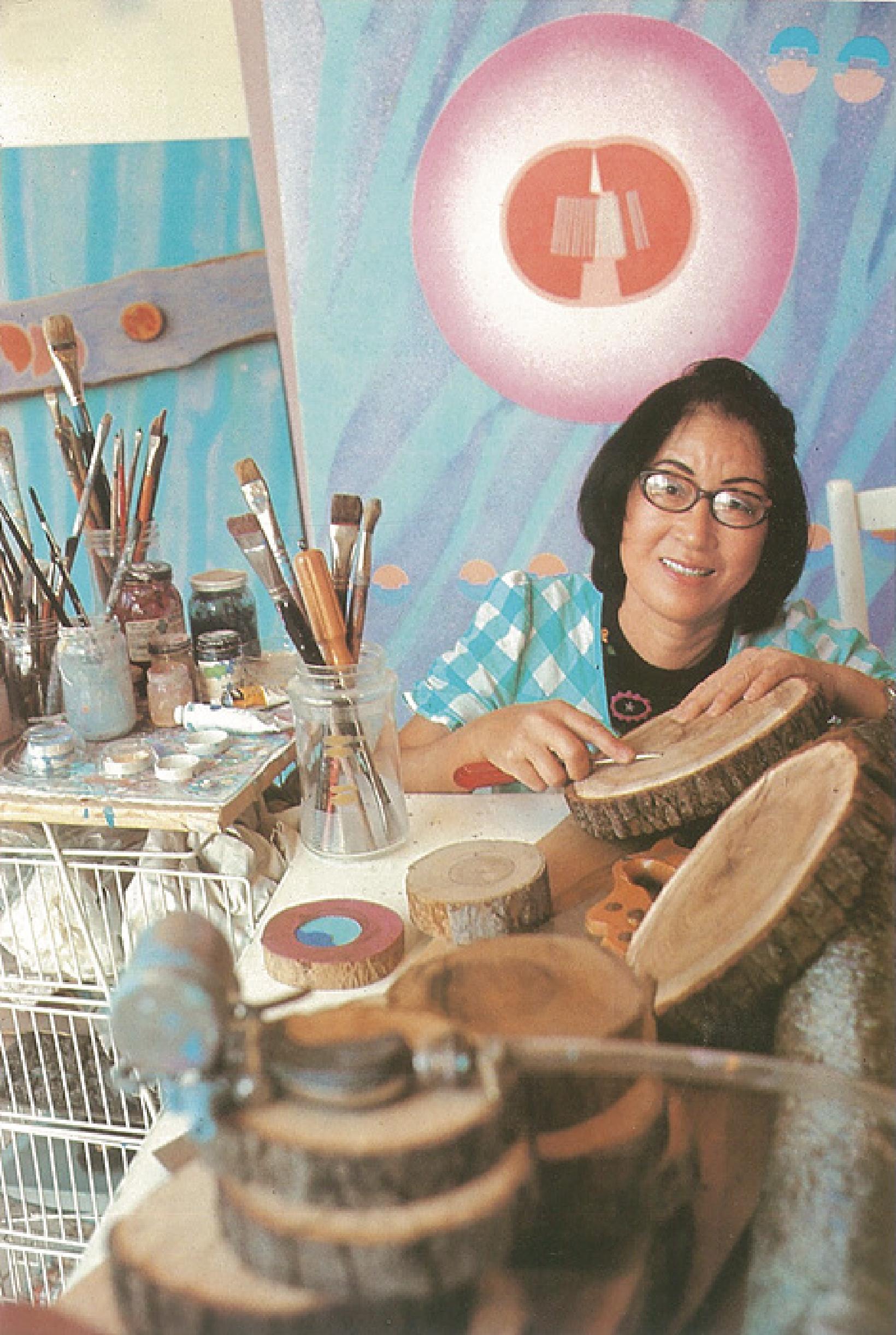Seundja Rhee (1918-2009) left Korea for Paris in 1951 and began her studies of formative arts, eventually forming an extensive oeuvre of Western painting and woodblock prints throughout her life. Her works attempted a marriage of the formative arts and literature, while the body of work she left behind transcends time and demonstrates her creative powers that encompassed not only painting but also pottery, tapestry, mosaic, and poetry. While diverse, she is well known for her explorations in abstraction utilizing geometric patterns and the incorporation of Korean symbols and text. She regarded the Eastern philosophical concept of yin and yang as the most important basis of her work.
While spending the majority of her practicing years in France and having been influenced by the French schools of art, her themes and subject matters reflect her personal sentimentalities and experiences as a Korean. At a time when many Korean artists dreamed of moving to France, she made her first trip to France in 1950 and enrolled in Académie de la Grande Chaumière in 1953 to study painting for the first time in her life, under the guidance of the renowned modernist artist Henri Goetz.
Rhee has exhibited in numerous institutions including, among others, the National Museum of Modern Art Paris, Museum of Modern Art Ljubljana, Center Pompidou, National Museum of Modern Art Tokyo, Gyeongnam Art Museum, and the Seoul Museum of Art. She was introduced to the Korean audiences for the first time in 1965 and has held consecutive solo exhibitions at the National Museum of Modern and Contemporary Art, Korea (MMCA) in 1970, 1978, 1988, and her fourth solo exhibition in March of 2018 celebrated the 100th anniversary of this significant female artist.
Rhee’s works are on display at major art institutions within and outside Korea such as the National Museum of Modern and Contemporary Art, Korea, Leeum, Museum of Modern Art at Saint-Etienne, Nantes Art Museum, National Museum of Modern Art in Paris, and Musee d’Art modern de la ville de Paris.
이성자 화백은 도불 작가 1세대로 현재까지 70회 이상의 개인전 및 300회 이상의 단체전을 전 세계 각지에서 개최하였다. 에꼴 드 파리 소속 유일한 한국 화가인 이성자 화백은 또한 타피스트리, 모자이크, 도자기 등의 작품 활동도 했다. 1951년 프랑스로 건너가 본격적인 창작활동에 들어간 이 화백은 유화, 목판화 비롯, 70년대 이후의 도자기 등 모든 조형 작품에 동양적 향취와 이미지를 담은 방대한 규모로 꾸준히 제작했다. 그녀만이 표현할 수 있는 한국적 사상과 시정은 프랑스 미술계에도 적지 않은 영향을 미쳐 그 흐름 속에 합류되었고 유럽에서 작업하는 작가들의 본보기가 되었다. 이후 프랑스는 물론 세계 전역에 걸쳐 작가로서의 지위를 굳혀온 이 화백은 대표적 한국 원로 작가이다. 파리 시립 미술관장이었던 J.라세뉴는 『이성자씨는 자신의 동양적인 유산에서 나온 오묘한 성격을 그대로 간직한 채 서양미술의 흐름 속에 용기 있게 합류하는 본보기』라고 호평하였고, 파리가 공식적으로 인정하는 동양의 예술가로 『동녘의 대사 (ambassadrice de l'aube)』라는 애칭을 얻기도 했다. 이성자 화백은 향년 91세의 일기로 2009년 타계했다.
이성자의 작품 세계는, 작품의 재질을 처리하는 방식에 있어서 구상과 추상이 작품에 동시에 보여졌던 초기의 ‘구상과 추상’ 작품을 거쳐, 대지에 대한 관심이 경작의 모습으로 반영되어 어머니가 자식을 길러내는 듯한 모티브를 표출하는 ‘대지와 여성’, 1969년 방문했던 뉴욕의 엠파이어 스테이트 빌딩을 보고 받은 느낌을 끊김이 없는 원의 이미지 사용으로 발전시켰던 ‘겹침과 도시’, 이전의 작품들과는 다른 자연주의적 표현 방법으로 지중해의 풍경에 자신의 심정을 담은 색과 아름다움으로 표현한 ‘자연’으로 이어지며, 이번 전시에서도 선보이는 ‘대척지로 가는 길’과 ‘우주’로 발전되어 오고 있다.
이성자의 최근 작품들은 우주 전체를 관망하고 있다. 우주를 떠도는 유영(遊泳)과도 같은 예술가의 삶을 사는 작가 이성자는 수천 개의 색색의 물방울들이 하늘로 떠오르며 인간과 자연에게 사랑과 믿음의 메시지를 보내는 형태를 빌어 자신의 그림 안에서 우주를 구성하는 상징 요소로서 위치한다. ‘은하수에 있는 나의 오두막Mon Auberge de Galaxie’이라는 작품의 제목처럼 행성들은 관람자의 방문을 기꺼이 환영하는 친밀한 곳이기도 하다. 그것은 이제 모든 대립되는 요소들의 화해를 말하고 있다. 그것은 이성자가 예술을 통해 습득한 지혜이자, 서울과 파리, 투레트에 나누어 가꿔온 그의 삶의 결과이기도 하다.
이성자는 한국이 낳은 걸출한 여성 미술가 등 중에서 나혜석과 최욱경의 중간에 위치한다고 할 수 있다. 프랑스의 대표적인 시인인 미쉘 뷔토르가 칭송했던 것처럼 ‘동녘의 여대사’로서의 삶을 충실히 살아온 그는 동양과 서양의 넘나들 수 없을 것만 같은 간극을 넘는 것에 자신의 평생을 바쳤다. 그는 실존의 부조리를 부여잡고 통곡하는 동시대 미학의 자폐적 우울증에서 벗어나 환희에 찬 노래와 춤의 미학을 추구했고, 스스로 삶과 예술이 일치하는 조화로운 세계를 완성하였다.
